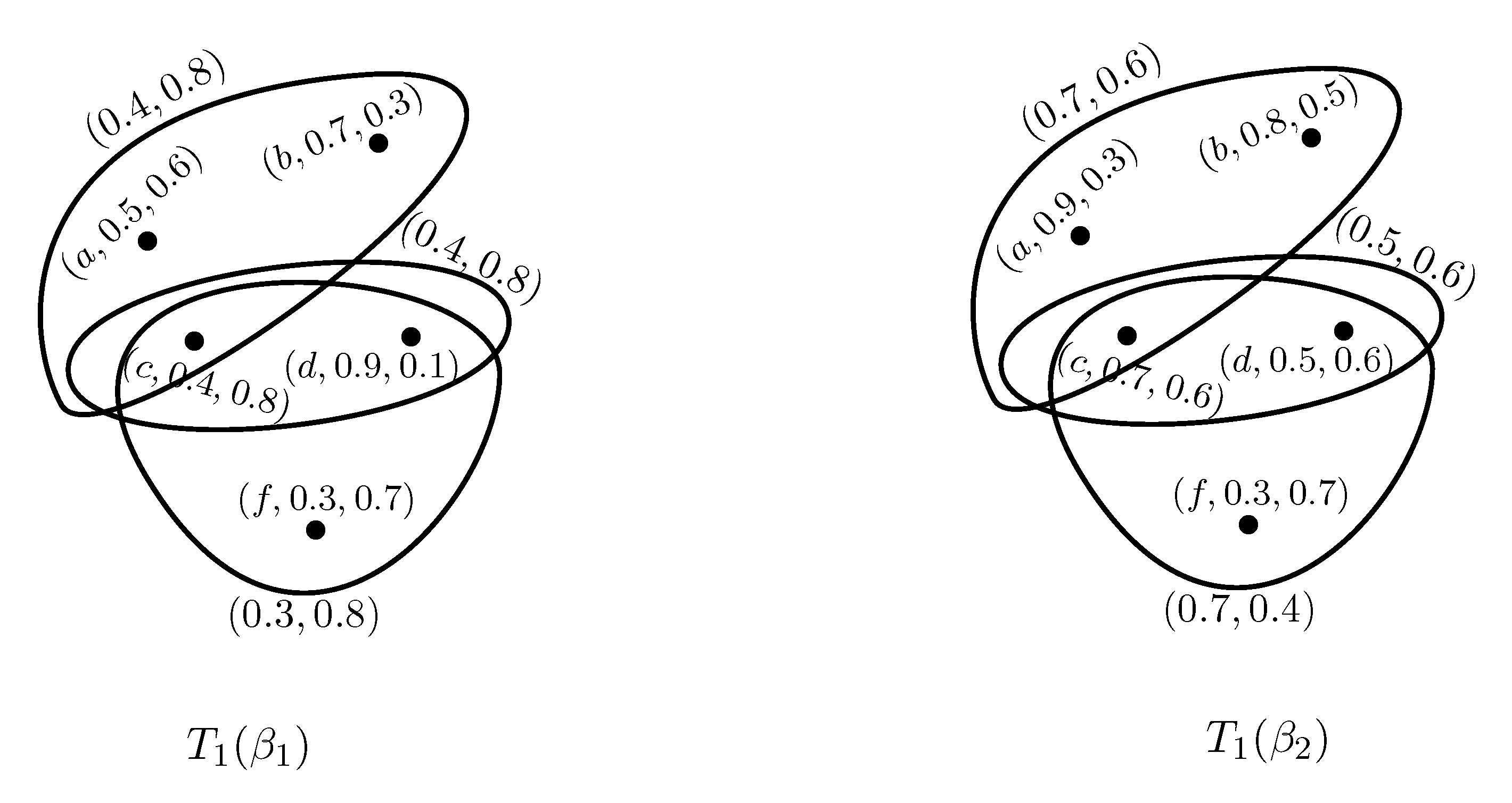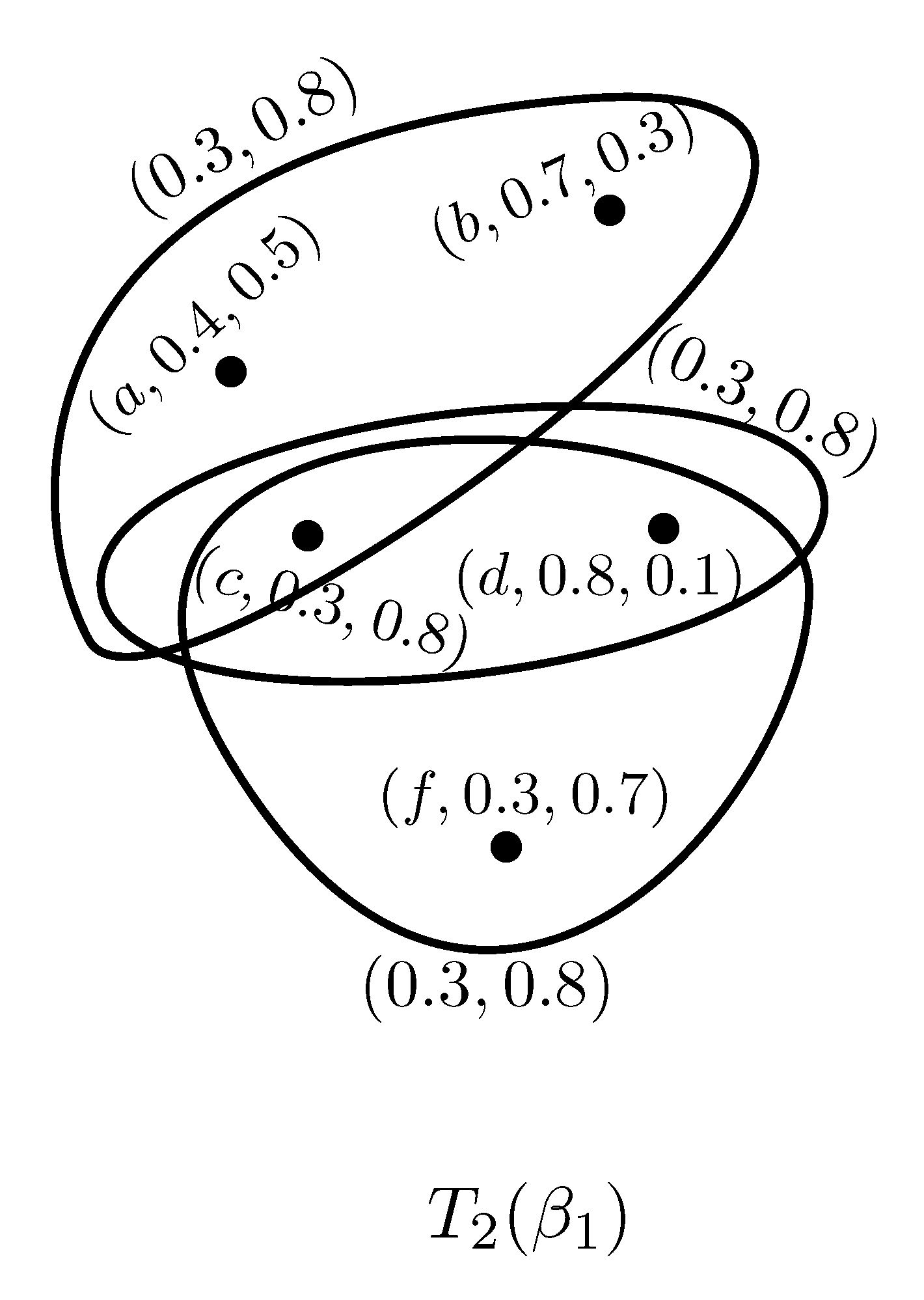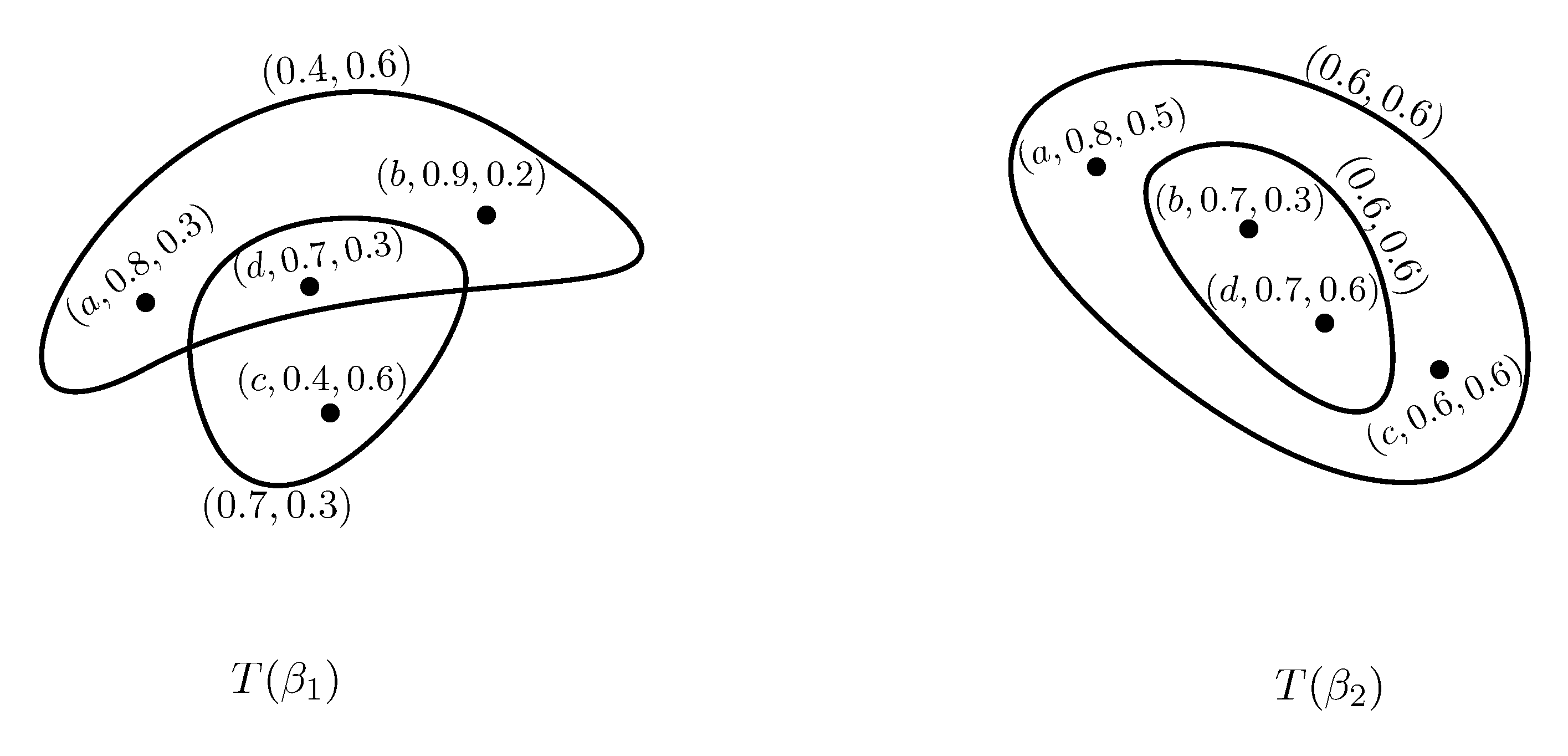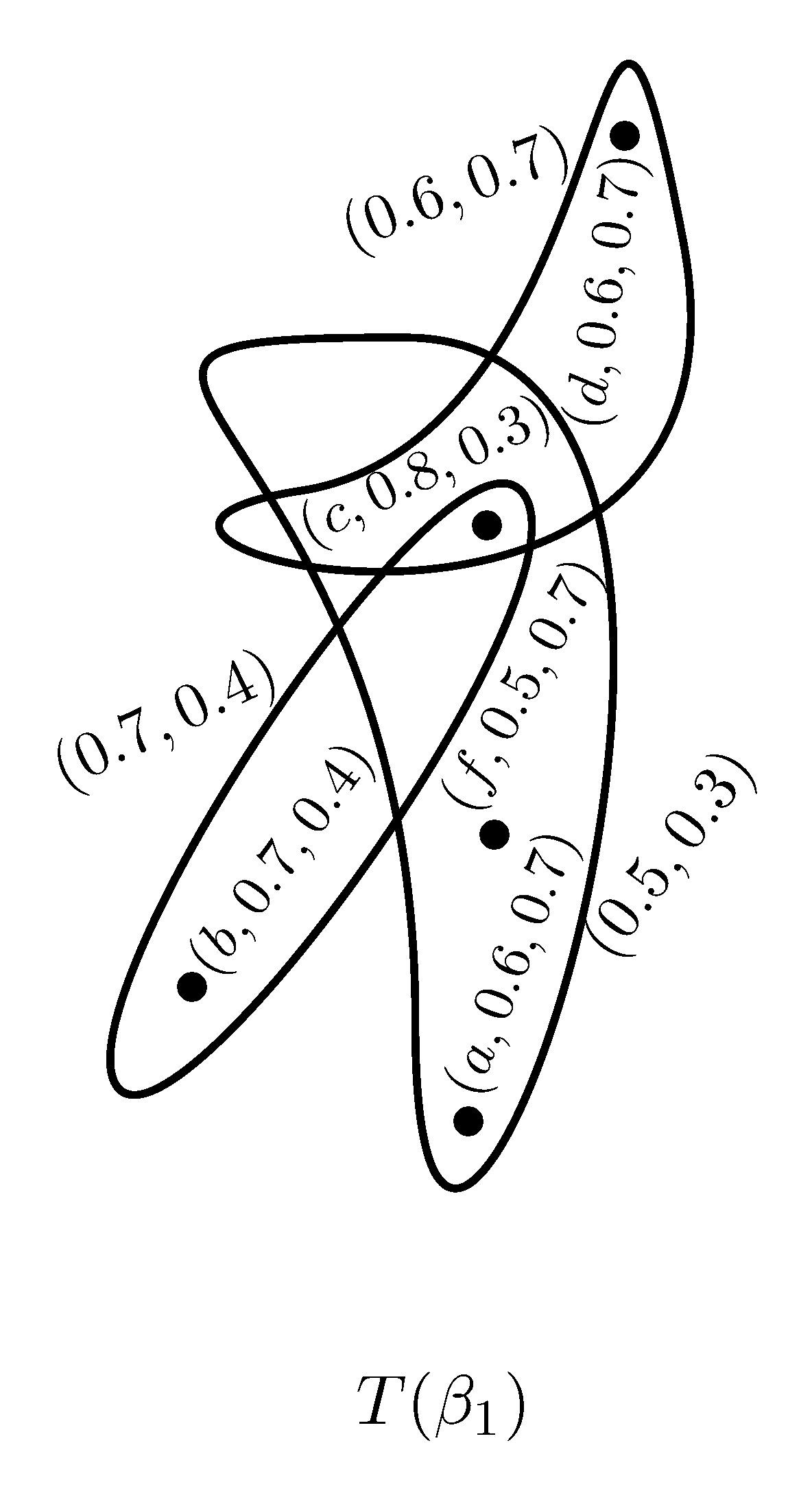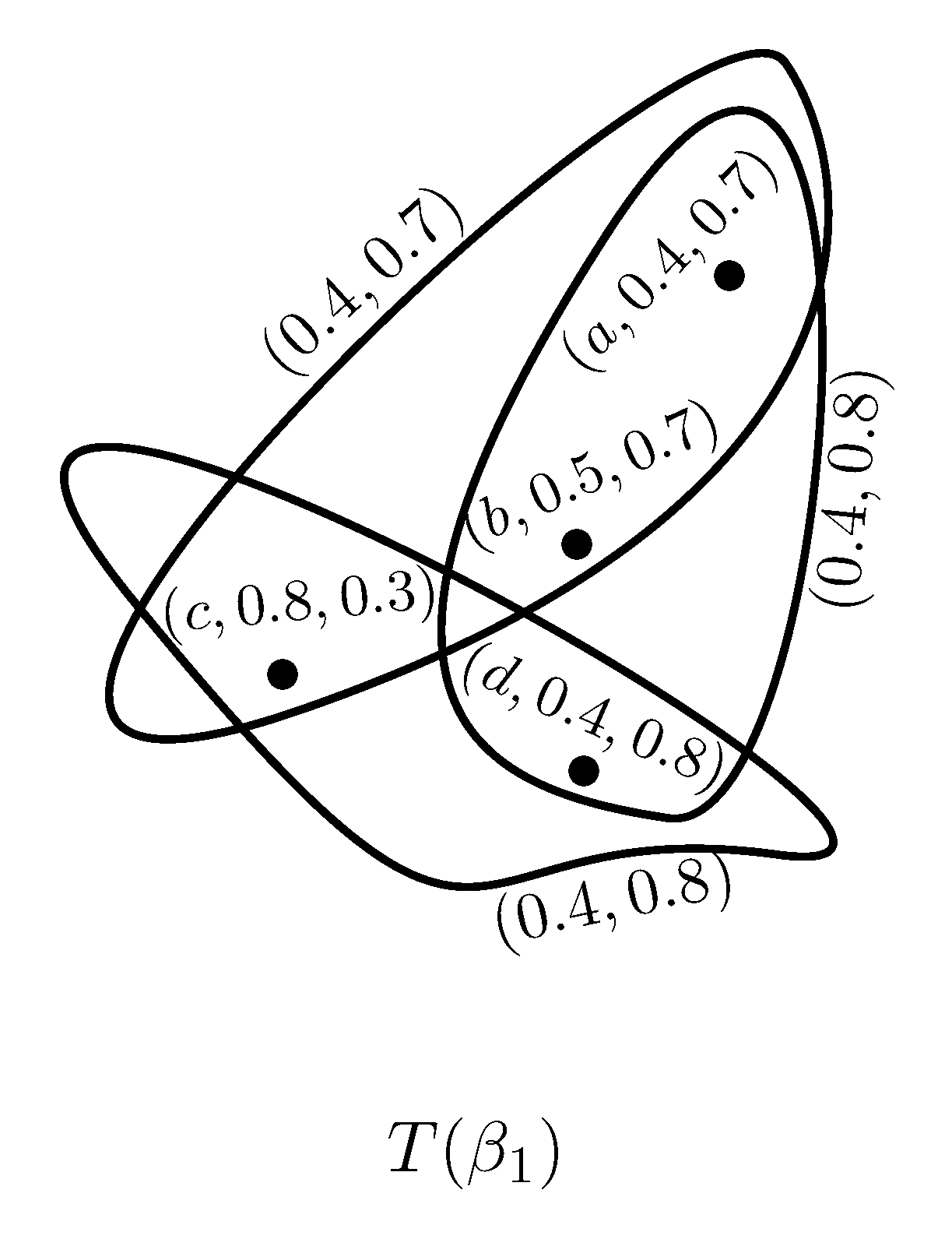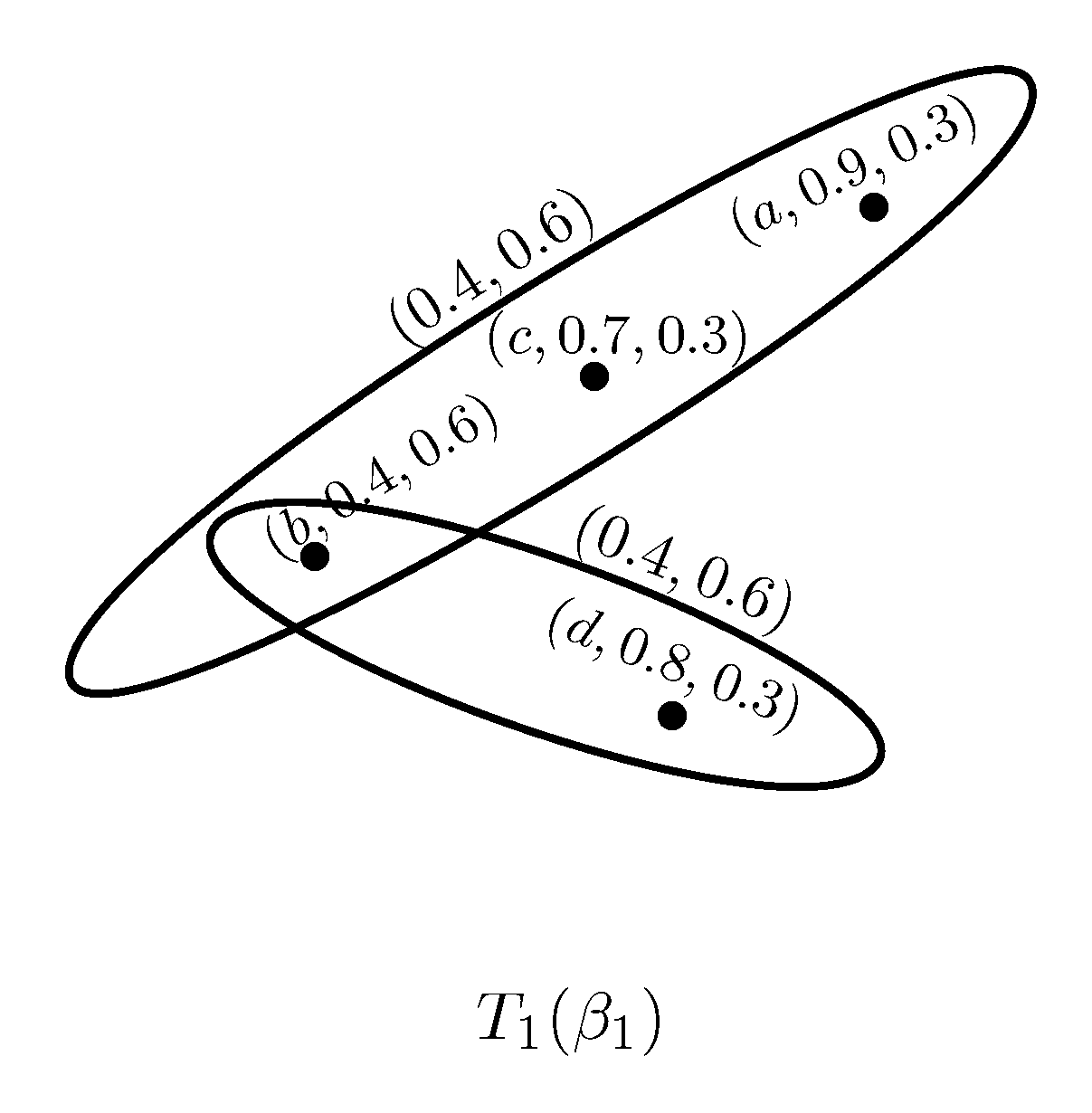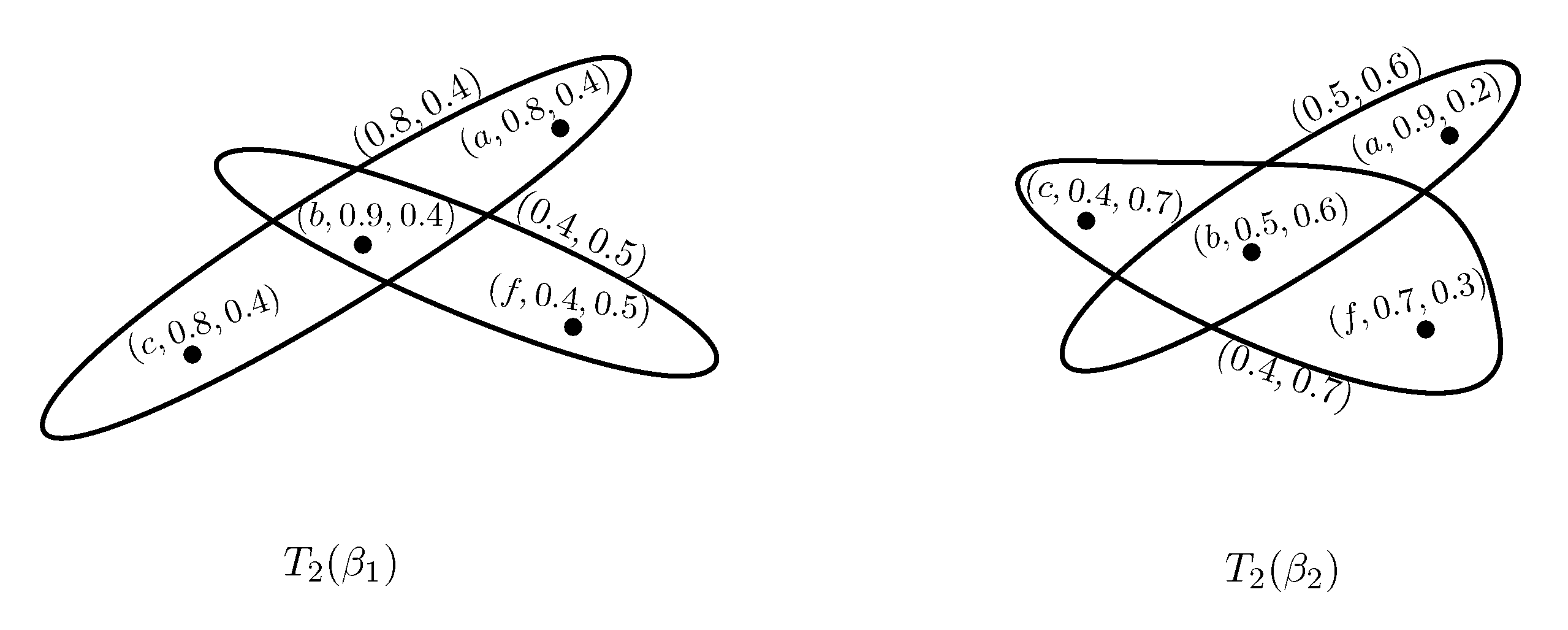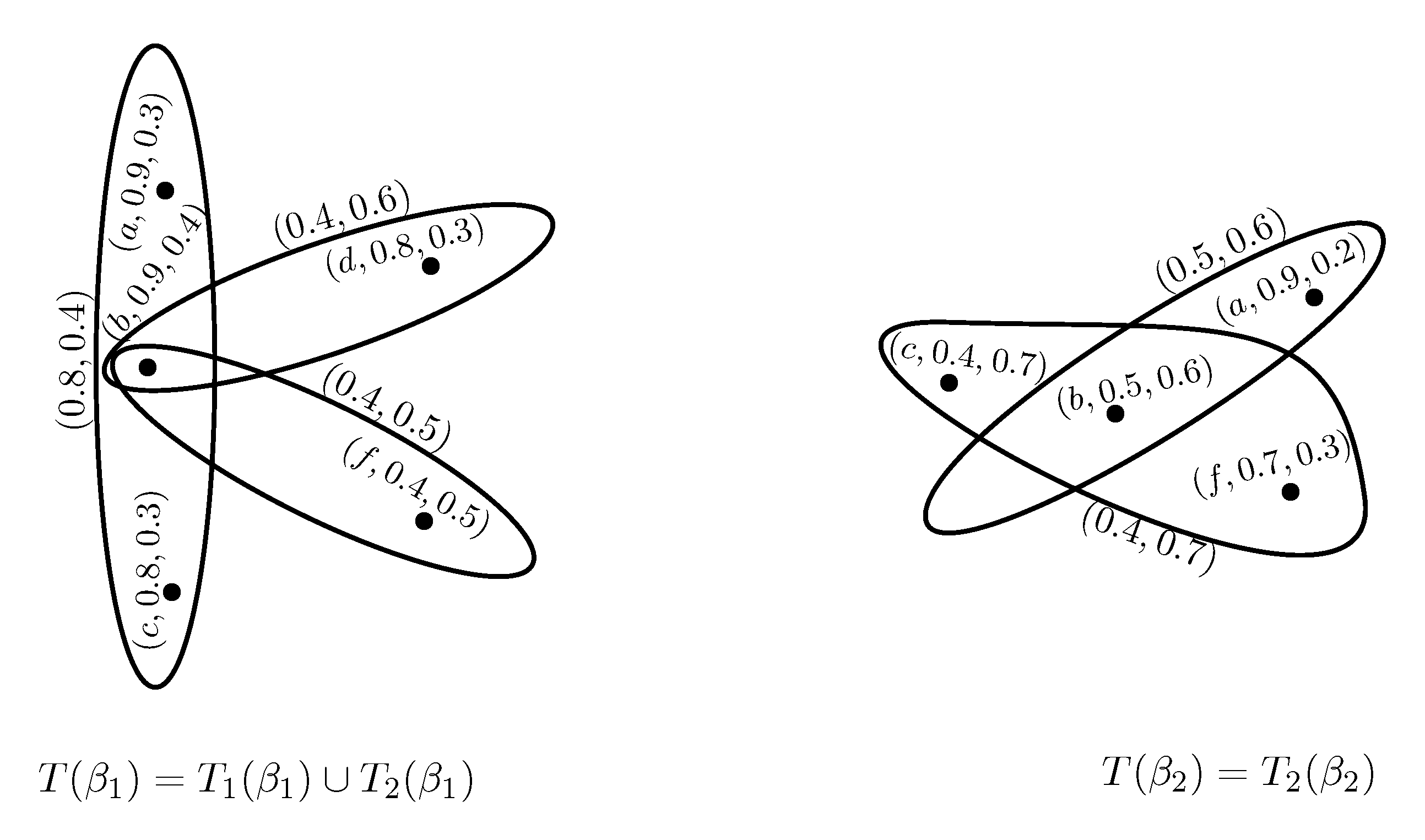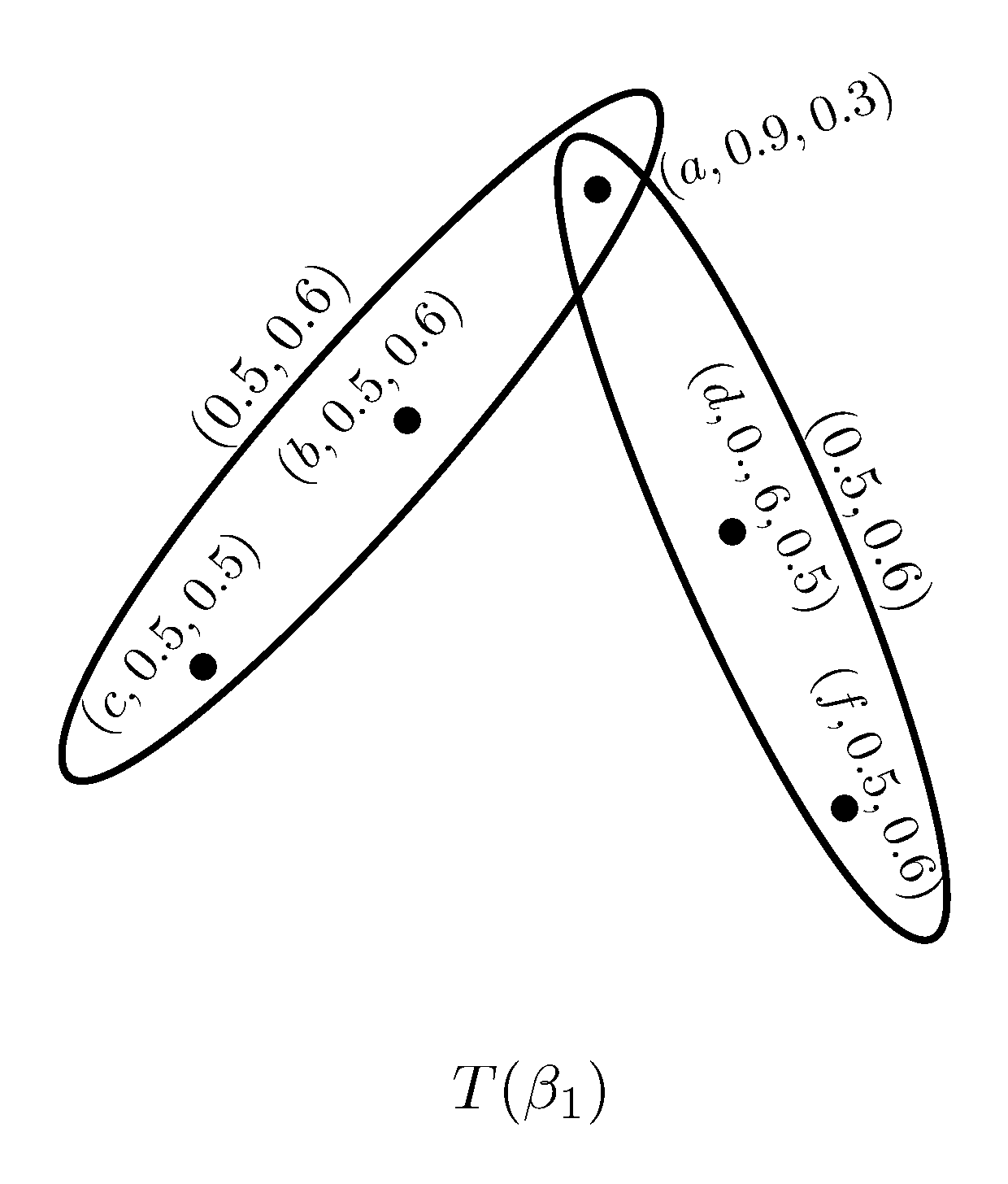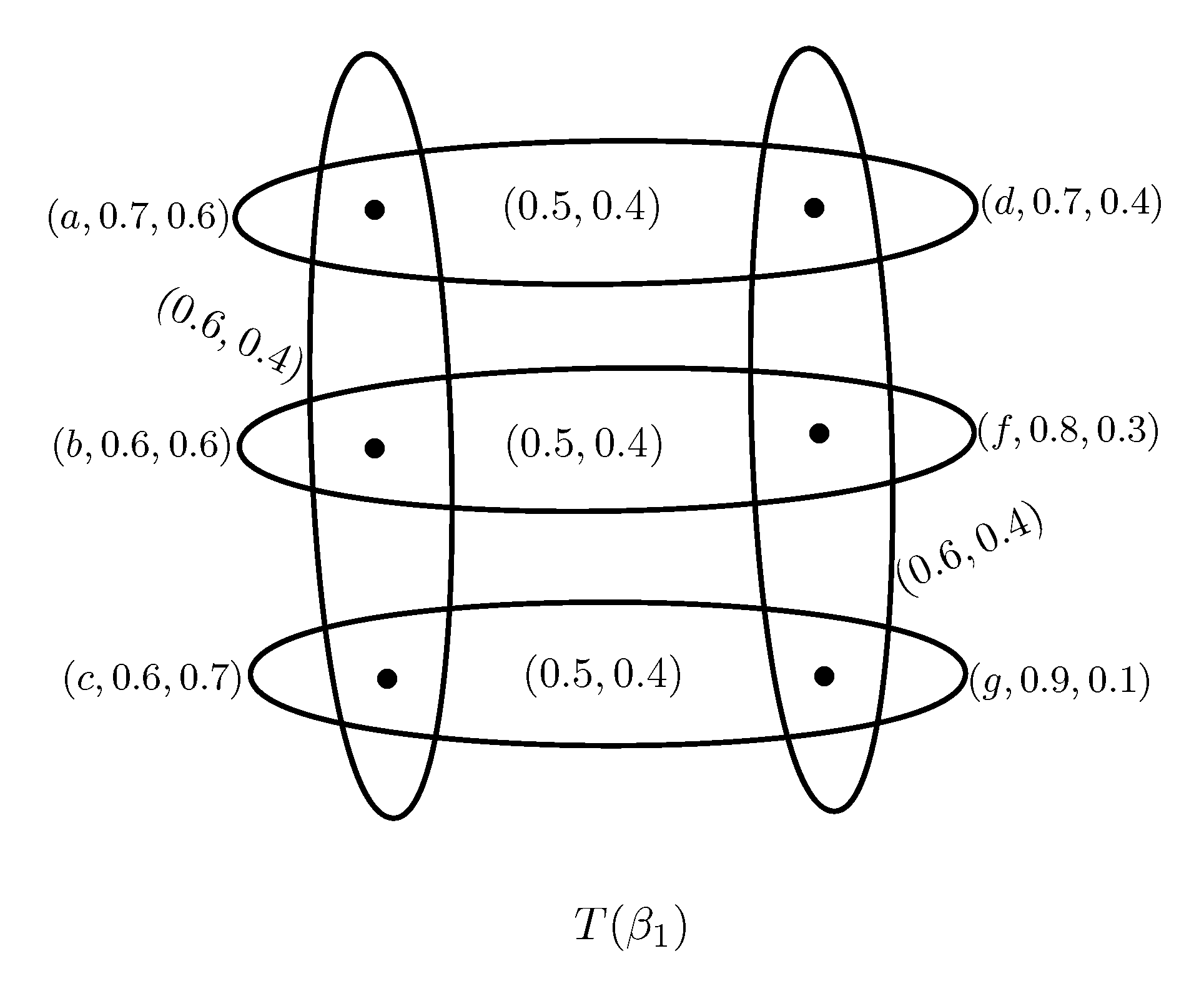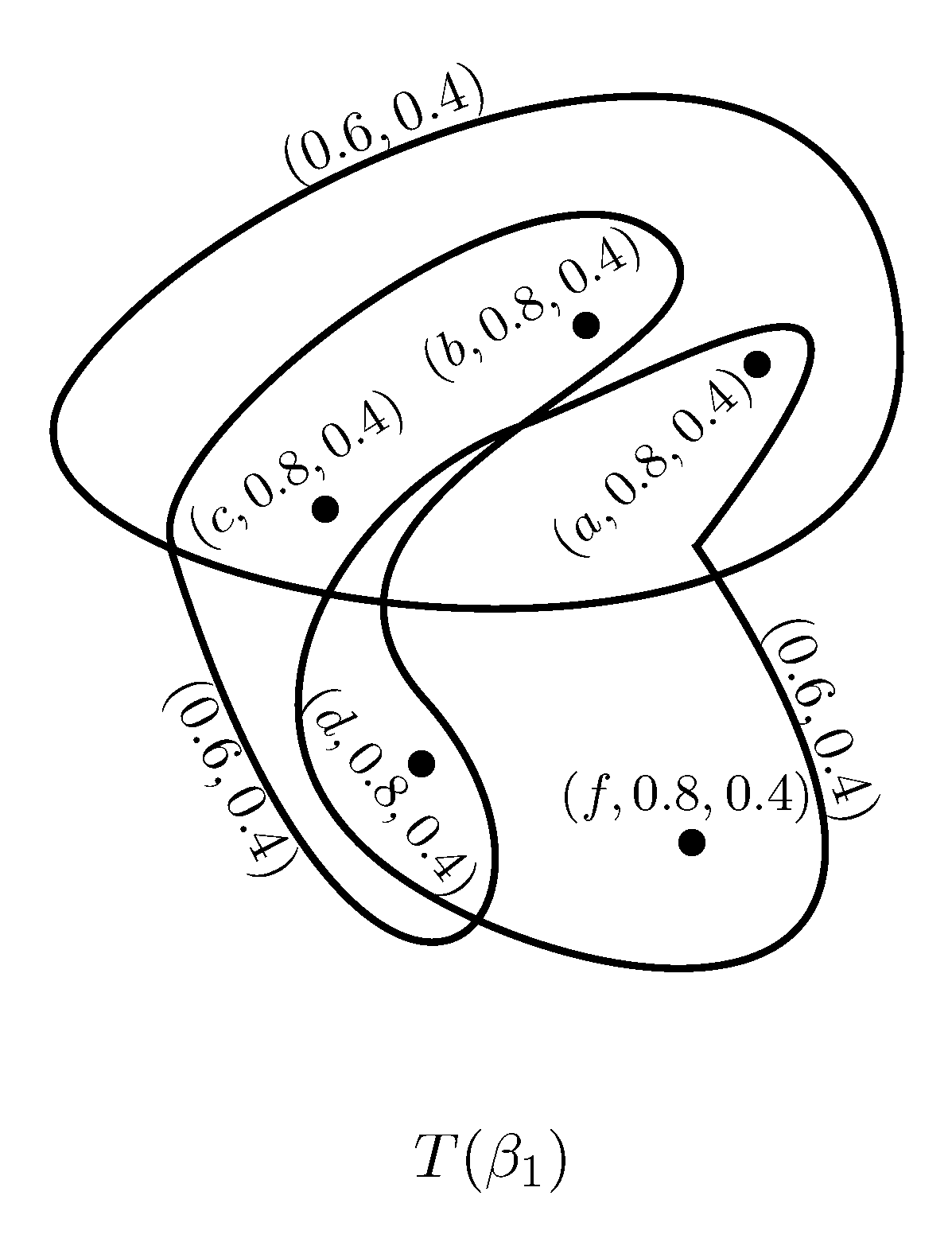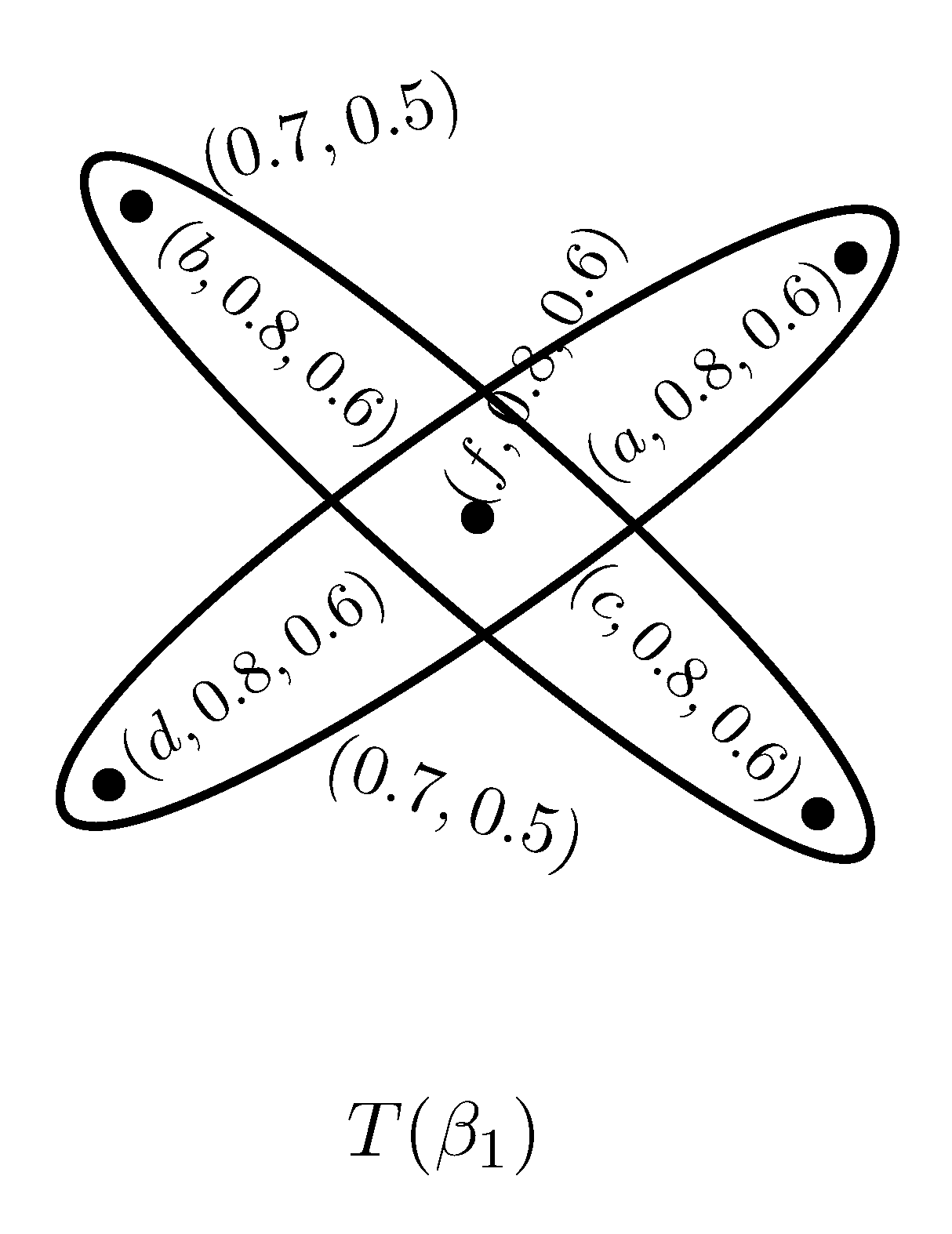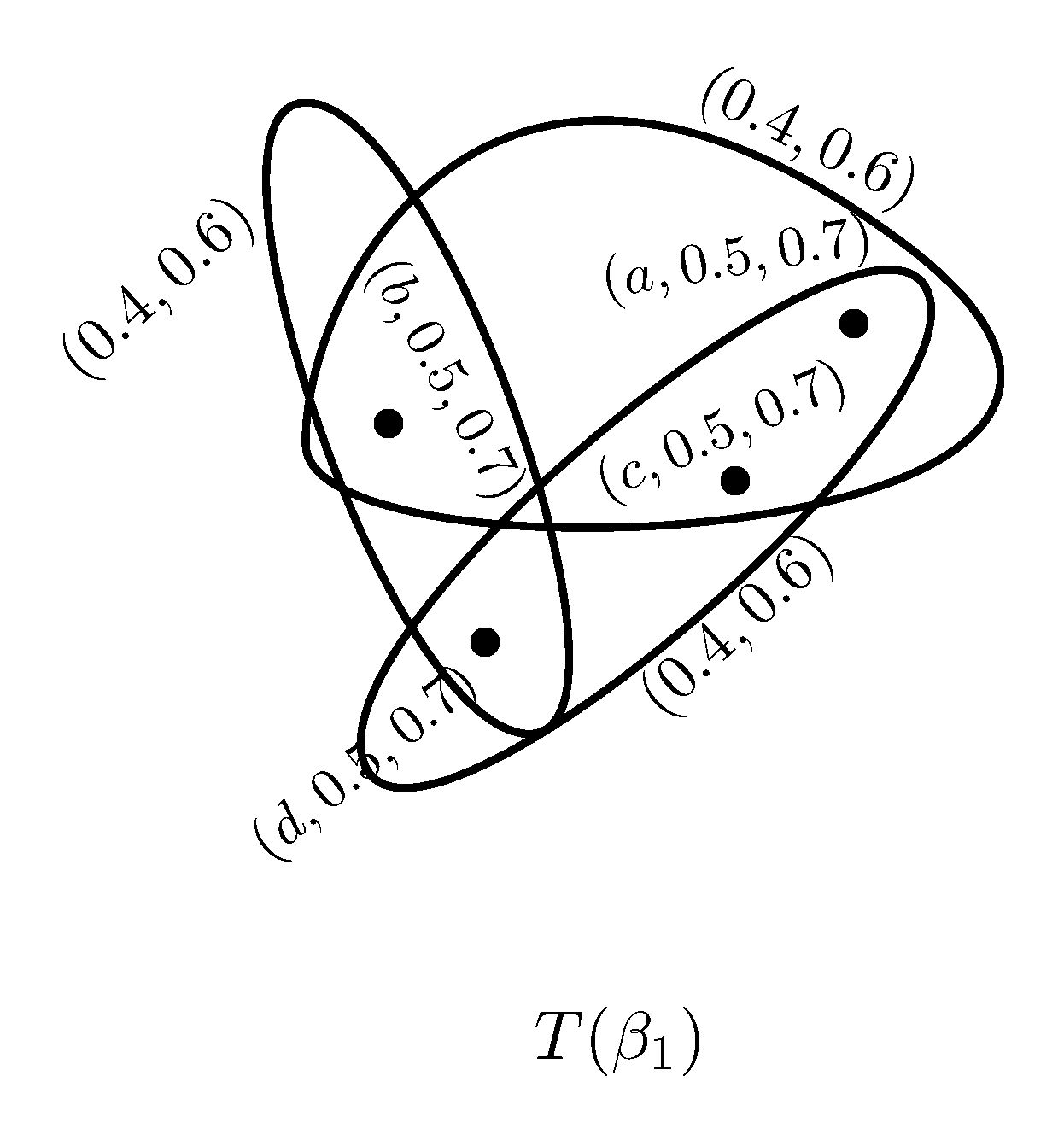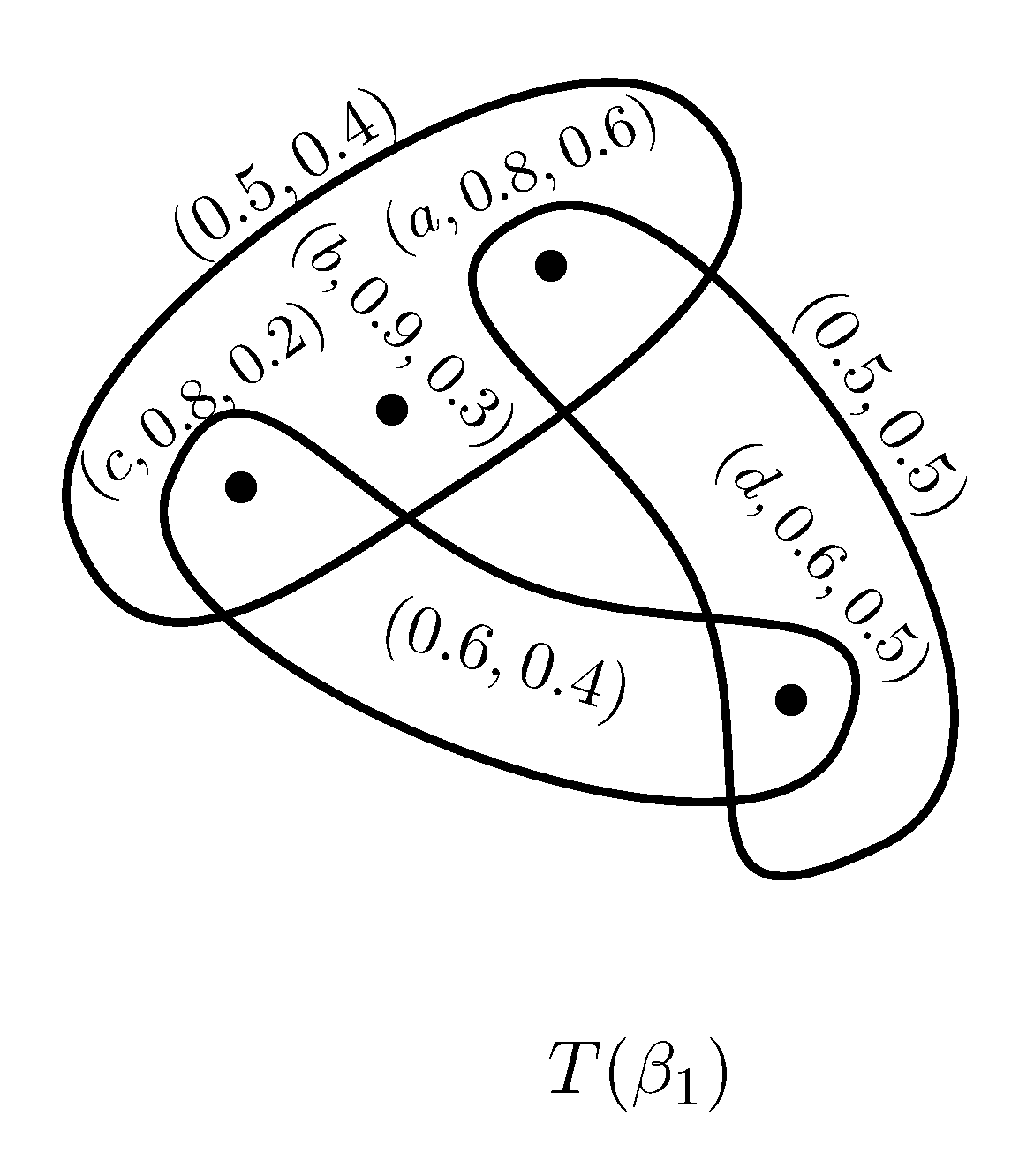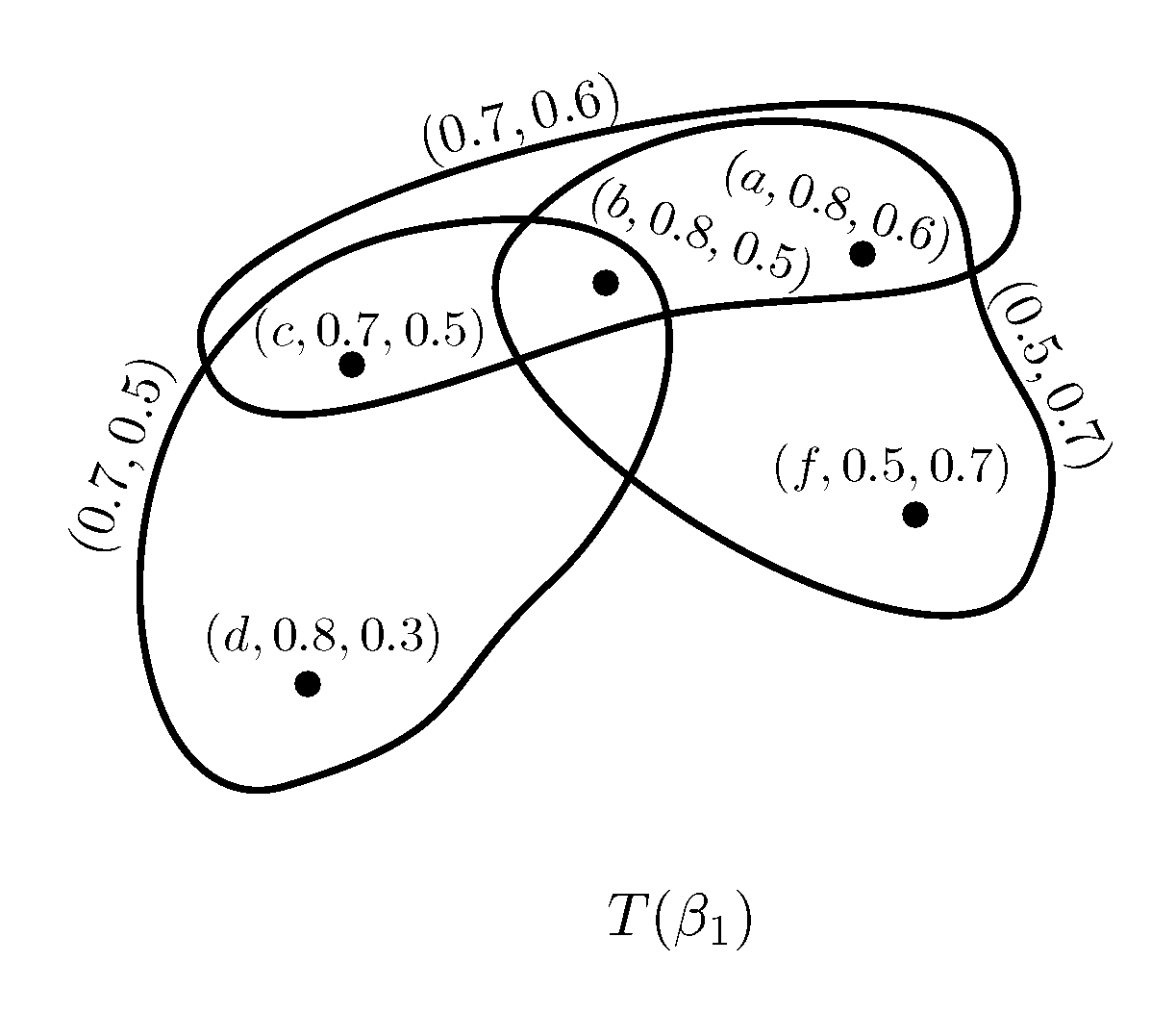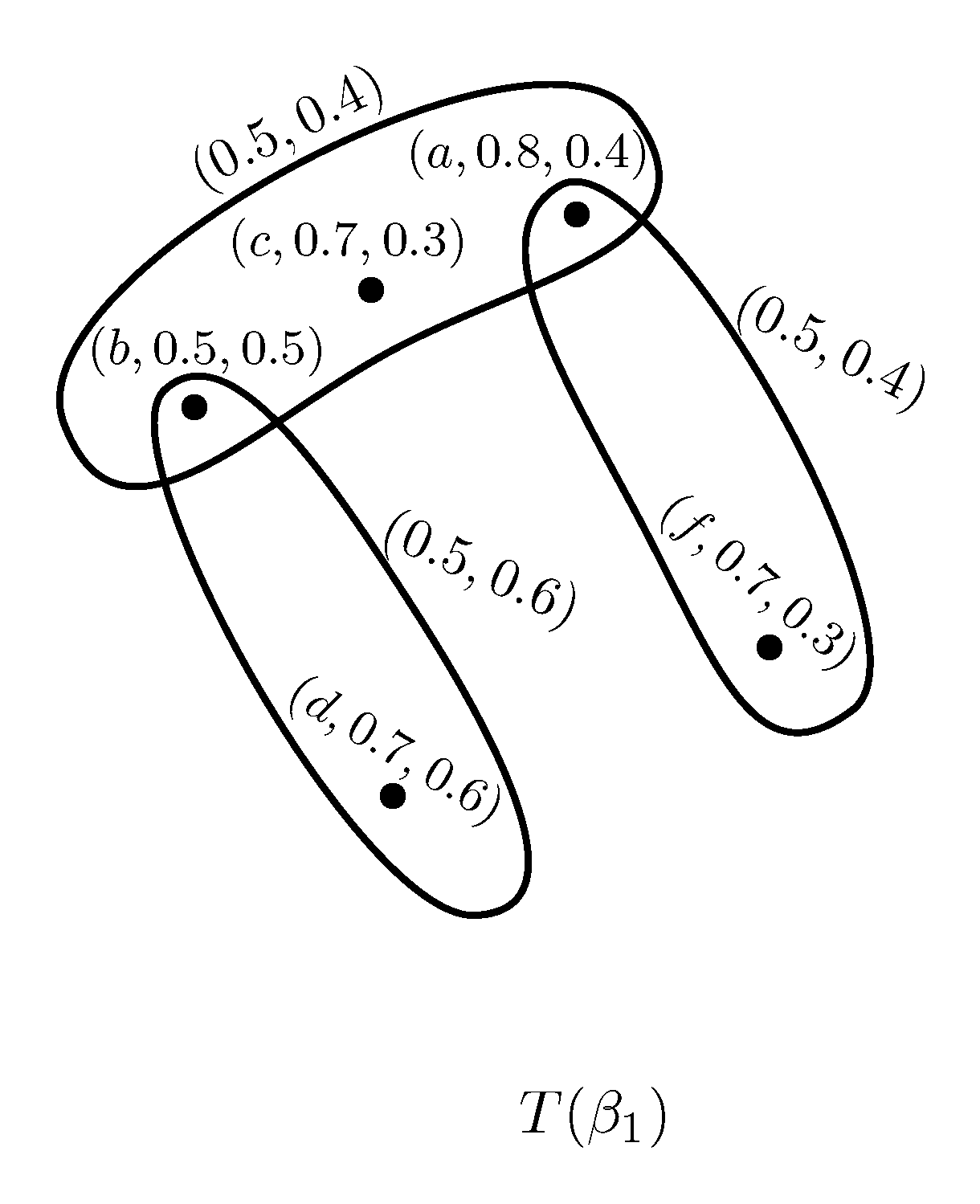1. Introduction
For the modeling and solution of combinative issues that appear in different areas, including mathematics, computer science, and engineering, graph theory has become a powerful theoretical structure but only pairwise relationships are represented by graphs. In several real-world applications, relationships are more problematic among the objects, then graph theory fails to handle such relationships when we consider more than two objects. Therefore, we use hypergraphs to represent the complex relationships among the objects. In case of a set of multiarity relations, hypergraphs are the generalization of graphs, in which a hypergraph may have more than two vertices. Hypergraphs have many applications in different fields including biological science, computer science, and discrete mathematics. There are a lot of complicated problems and notions in various fields such as rewriting systems, databases and logic programming, which can be interpreted using hypergraphs presented in [
1].
The notion of classical set (CS) theory is generalized by fuzzy set (FS) theory. In CS theory, information is either true or false but there is no information for the intermediate state. Many uncertain problems can be handled more accurately by using FS. Zadeh introduced the FS in 1965 to solve uncertainty problems [
2]. In complex phenomena, FS theory plays an important role which is not solved by CS theory. As an extension of FS, Atanassov [
3] illuminated the intuitionistic fuzzy set (IFS) by adding a non-membership function which satisfies the condition
. There are a lot of decision making problems, where the sum of membership and non-membership degrees of an object may be greater than 1 and square sum of its membership degree and non-membership degree is less than or equal to 1. To handle such difficulties, Yager [
4,
5] introduced the concept of Pythagorean fuzzy set (PFS) as an extension of IFS, which satisfies
and it relaxes the constraint of IFS. Multiparametric similarity measures on Pythagorean fuzzy sets were discussed by Peng et al. [
6]. Peng et al. [
7] studied Pythagorean fuzzy multi-criteria decision making method based on CODAS with new score function. Fei et al. [
8] worked on Pythagorean fuzzy (PF) decision making using soft likelihood functions. Fei et al. [
9] studied multi-criteria decision making in PF environment. For parameterized theory of uncertainty problems, Molodstov [
10] gave the idea of soft set (SS) theory. Fuzzy soft set (FSS) was defined by Maji et al. [
11] and using this concept in decision making problems, Roy and Maji [
12] established many applications. Peng et al. [
13] studied PFSSs and its applications.
Kaufmann [
14] gave the concept of fuzzy graphs (FGs) in 1973. Some operations on FGs were defined by Mordeson and Chang-Shyh [
15] in 1994. Parvathi and Karunambigai [
16] studied the notion of intuitionistic fuzzy graphs (IFGs). Naz et al. [
17] presented the view of Pythagorean fuzzy graphs (PFGs). Some new operations of PFGs were established by Akram et al. [
18]. The idea of fuzzy soft graphs (FSGs) was established by Akram and Nawaz [
19]. Shahzadi and Akram [
20] illustrated the concept of IFSGs. To overcome the uncertainty in crisp hypergraphs, the idea of fuzzy hypergraphs (FHs) was introduced by Kaufmann [
14]. Mordeson and Nair worked on FGs as well as FHs in [
21]. Chen [
22] gave the notion of interval-valued FHs. Lee Kwang and Lee [
23] examined the FHs with fuzzy partition. Bipolar neutrosophic hypergraphs with applications were presented by Akram and Luqman [
24]. Hypergraphs in
m-polar fuzzy environment are considered in [
25]. Thilagavathi [
26] gave the idea of intuitionistic fuzzy soft hyergraphs (IFSHs). Further new extensions of fuzzy hypergraphs are presented in [
27,
28]. In this paper, in
Section 3, we have combined the concepts of Pythagorean fuzzy soft sets and hypergraphs, and constructed PFSHs to deal the complexity in relationships corresponding to different parameters. We have introduced the concept of strong and complete PFSHs. We have discussed certain operations on PFSHs and regularity of PFSHs. In
Section 4, we have described steps of decision method. In
Section 5, we have described a decision making problem to obtain a competent team for business. In
Section 6, we have concluded our results related to our proposed model.
3. Pythagorean Fuzzy Soft Hypergraphs
Definition 3. A Pythagorean fuzzy soft hypergraph on a non-empty set X is a 3-tuple where, is a family of Pythagorean fuzzy soft subsets over X and is a Pythagorean fuzzy soft relation on the Pythagorean fuzzy soft subsets such that
1. ,
2. for all
3.
where is a PF subhypergraph for all
Example 1. We present directly a PFSH on which is shown in Figure 1, where Definition 4. Let and be two PFSHs. Then is a PFS subhypergraph of if
- 1.
,
- 2.
is a partial PF subhypergraph of for all .
Example 2. Consider two PFSHs and on as shown in Figure 2 and Figure 3, where and . Clearly, and is a partial PF subhypergraph of for all . Hence is a PFS subhypergraph of .
Theorem 1. Let and be two PFSHs. Then is a PFS subhypergraph of iff and for all
Proof. Suppose that is a PFS subhypergraph of . Then and is a partial PF subhypergraph of for all . Clearly, and for all
Conversely, suppose that and , for all Since is a PFS hypergraph, is a PF subhypergraph for all . Thus is a partial PF subhypergraph of for all . Hence is a PFS subgraph of . □
Definition 5. The PFSH is called spanning PFS subhypergraph of if
- 1.
- 2.
for all . There is no any restriction for arc weights.
Definition 6. The order of a PFSH is
Definition 7. The size of a PFSH is
Example 3. Consider a PFSH on as shown in Figure 4, where Then the order of PFSH is Definition 8. A PFSH H is a strong PFSH if is a strong PFH for all . That is,
,
,
for all
Example 4. Consider a PFSH on , where It is cleared from Figure 5 that H is a strong PFSH. Definition 9. A PFSH H is a complete PFSH if is a strong PFH for all . That is,
,
,
for all
Example 5. Consider a PFSH on , where It is cleared from Figure 6 that H is a complete PFSH. We now discuss some operations on PFSHs.
Definition 10. Let and be two PFSHs on and , respectively. Then union of and , denoted by , is a PFSH , where is a family of PFS subsets over and is a PFS relation on the PFS subsets and is a PFH for all defined by
where denotes the union of two PFHs for all .
Example 6. Consider two PFSHs and on and , respectively as shown in Figure 7 and Figure 8, where and The union of and is given in Figure 9. Theorem 2. Let and be two PFSHs such that Then their union is a PFSH.
Proof. The union of and is defined by where and
Since is a PFSH then is a PFH for all . Since is also a PFSH then is also a PFH for all . Since union of two PFHs is a PFH, is a PFH for all . Therefore, is a PFH for all . Thus is a PFSH. □
Definition 11. Let and be two PFSHs on and , respectively. Then Cartesian product of and is a PFSH , where and are Pythagorean fuzzy subsets of and and and are Pythagorean fuzzy subsets of and and is a PFH for all . That is, = , is a PFH. Theorem 3. The Cartesian product of two PFSHs is a PFSH.
Proof. Let and be two PFSHs. Let be the Cartesian product of and , for . We claim that is a PFSH. Let , suppose contains p vertices, where and , suppose contains q vertices, where . Then we have
Case (i): Let
.
and
Similarly, we can show that
,
□
Definition 12. Let and be two PFSHs on and , respectively. Then the composition product of and is a PFSH , where and are Pythagorean fuzzy subsets of and and and are Pythagorean fuzzy subsets of and and is a PFH for all . That is,
= , is a PFH.
Theorem 4. The composition product of two PFSHs is a PFSH.
Proof. Case (i): Let
.
and
Similarly, we can show that for case (ii)
,
Case (iii): Let
.
and
□
Now we define the concept of a PFS uniform hypergraph and strong and lexicographic products of PFS uniform hypergraphs.
Definition 13. A PFSH H is called a PFS uniform hypergraph if is a PF -uniform hypergraph, i.e, for all , .
Example 7. Consider a PFSH H on where . It is cleared from Figure 10 that H is a PFS uniform hypergraph. Definition 14. Let and be two PFS uniform hypergraphs on and , respectively. Then strong product of and is a PFS uniform hypergraph , where and are Pythagorean fuzzy subsets of and and and are Pythagorean fuzzy subsets of and and is a PFH for all . That is, = , is a PFH.
Theorem 5. If and are the PFS uniform hypergraphs, then is a PFS uniform hypergraph.
Proof. Case (i): Let
.
and
Similarly, we can show that for case (ii)
,
Case (iii): Let
.
and
□
Definition 15. Let and be two PFS uniform hypergraphs on and , respectively. Then lexicographic product of and is a PFS uniform hypergraph , where and are Pythagorean fuzzy subsets of and and and are Pythagorean fuzzy subsets of and and is a PFH for all . That is, = , is a PFH. Theorem 6. If and are the PFS uniform hypergraphs, then is a PFS uniform hypergraph.
Proof. By using similar arguments as used in Theorem 5, we can prove this result. □
We describe here regular and perfectly regular PFSHs.
Definition 16. Let H be a PFSH on X. Then H is said to be regular PFSH if is a regular PFH for all . If is a regular PFH of degree for all , then H is a regular PFSH. The degree of a vertex x is defined as Example 8. Consider a PFSH H on , where . As . Hence, is a regular PFSH as shown in Figure 11. Definition 17. Let H be a PFSH on X. Then H is said to be totally regular PFSH if is a totally regular PFH for all . If is a totally regular PFH of degree for all , then H is a totally regular PFSH. As Example 9. Consider a PFSH H on , where . It is cleared from Figure 12 that H is a totally regular PFSH. Theorem 7. Let H be a PFSH on X. If H is a regular PFSH and L is a constant function in PFH for all . Then H is a totally regular PFSH.
Proof. Suppose that H is a regular PFSH and L is a constant function. Then , are constant, , , and in PFHs , and . Since . This implies in PFHs , and . Hence H is a totally regular PFSH. □
Theorem 8. Let H be a PFSH on X. If H is a totally regular PFSH and L is a constant function in PFH for all Then H is a regular PFSH.
Proof. Suppose that H is a totally regular PFSH and L is a constant function. Then , are constant, , , and in , and . Since . This implies in , and . This implies in PFHs , and . Hence H is a regular PFSH. □
Theorem 9. If H is both regular and totally regular PFSH. Then L is a constant function in , .
Proof. Let H be both regular and totally regular PFSH. Then and in PF sub-hypergraphs for all and . This implies in , and . This implies in , . This implies in , and . Hence L is a constant in , and . □
The converse of above theorem is not true as shown in the following example.
Example 10. Clearly, L is a constant function in Figure 13, but not a regular and totally regular PFSH. Definition 18. Let H be a PFSH on X. Then H is said to be perfectly regular PFSH if is a regular and totally regular PFH for all .
We present notion of perfectly irregular PFSHs.
Definition 19. A PFSH is said to be neighborly irregular PFSH if is neighborly irregular PFH , i.e, if the degree of every pair of adjacent vertices of are distinct, .
Definition 20. A PFSH is said to be totally neighborly irregular PFSH if is totally neighborly irregular PFH , i.e., if the total degree of every pair of adjacent vertices of are distinct, .
Definition 21. A PFSH H is said to be perfectly irregular if is perfectly irregular PFH for all , i.e,
1. The degrees of all vertices of are distinct,
2. The total degrees of all vertices of are distinct.
Example 13. As each vertex in has distinct degree and total degree, so is perfectly irregular PFH. Hence, H is perfectly irregular PFSH.
Theorem 10. If H is perfectly irregular PFSH, then H is necessarily neighborly irregular, totally neighborly irregular and highly irregular PFSH.
Proof. Let H be a perfectly irregular PFSH. So every vertex of are of different degrees. Then every two adjacent vertices of are of different degrees. Therefore, is neighborly irregular PFH. Hence H is neighborly irregular PFSH.
Since H is perfectly irregular PFSH, the total degrees of all the vertices of are distinct. Then every two adjacent vertices of are of different degrees. Therefore, is totally neighborly irregular PFH. Hence, H is totally neighborly irregular PFSH.
Since H is perfectly irregular PFSH, the degrees of all the vertices of are distinct. Thus the degrees of the adjacent vertices of every vertex of are distinct. Therefore, is highly irregular PFH. Hence H is highly irregular PFSH. □
Example 14. , , , , . Thus, H is neighborly irregular PFSH. Also, , , , , . Thus H is totally neighborly irregular PFSH. But , so H is not perfectly irregular PFSH.
Similarly, we can show that there exists a PFSH H, which is highly irregular PFSH but not perfectly irregular PFSH.
Theorem 11. The sufficient condition of a neighborly irregular and totally neighborly irregular PFSH to be perfectly irregular PFSH is that if every pair of vertices of are connected through an hyperedge.
Proof. Let H be a neighborly irregular and totally neighborly irregular PFSH and every pair of vertices of are connected through an hyperedge. Since H is neighborly irregular PFSH, so for all adjacent vertices ⋯(1)
As every pair of vertices of are connected through a hyperedge. This means every pair of vertices of are adjacent, i.e, ⋯(2)
From (1) and (2), we have . Similarly, it can be proved that .
Therefore, the degree and total degree of all vertices of are distinct. Hence, is perfectly irregular PFH, . So H is perfectly irregular PFSH. □
Corollary 1. For a perfectly irregular PFSH, need not be constant.

